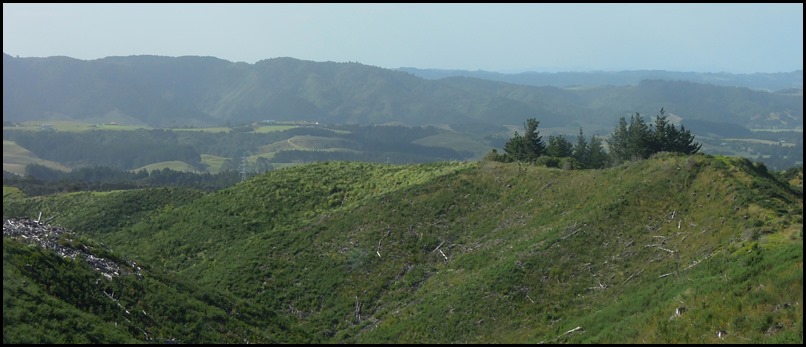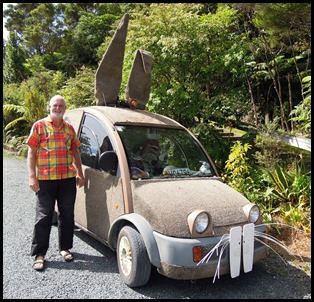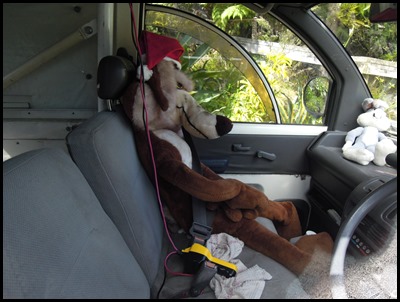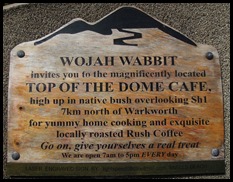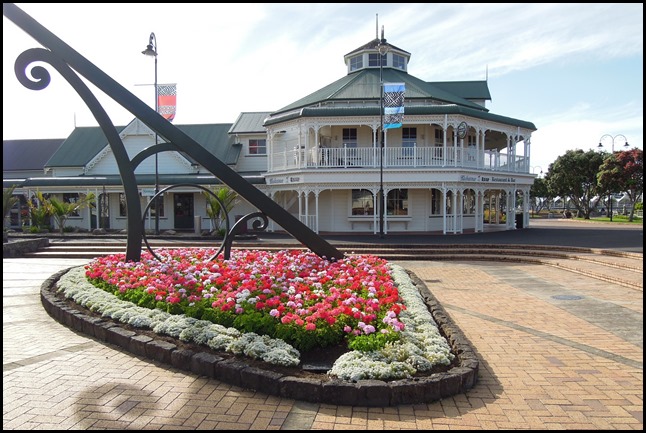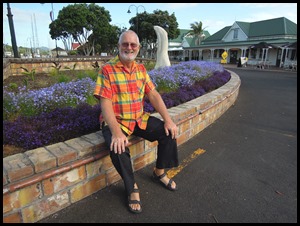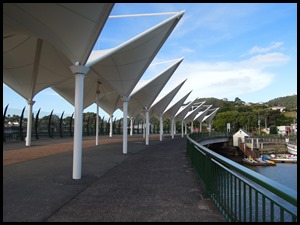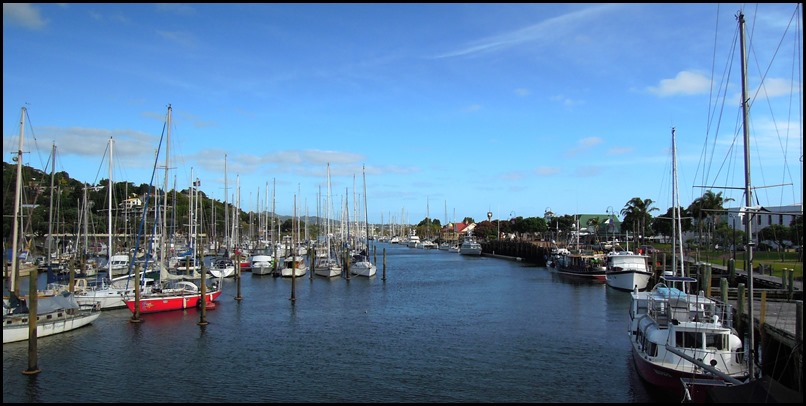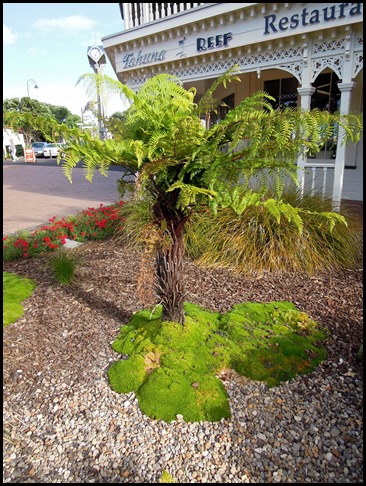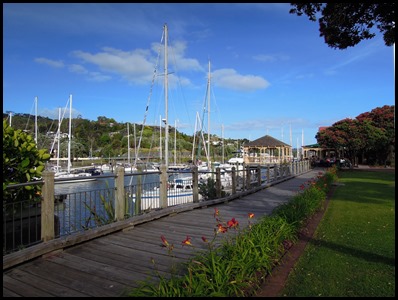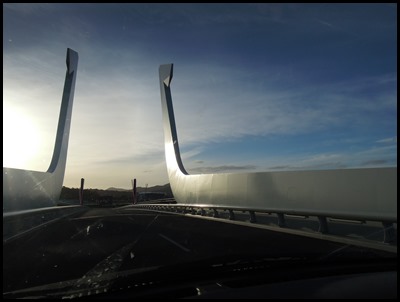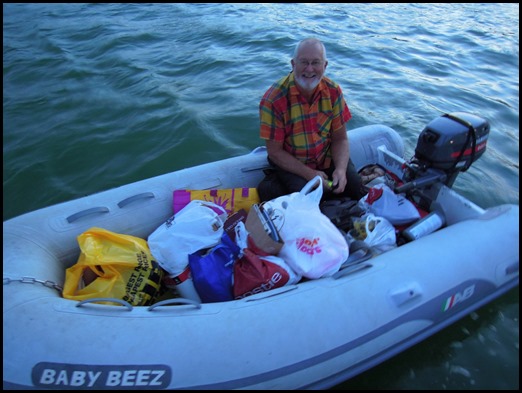To Opua via Whangarei

|
Te Tangata Whenua – The
People of the Land
We left Auckland, after my excitement of looking around the outside of Eden Park. About half back to Opua, we stopped at a sign for a lookout. We saw a great expanse of green and still cannot get over how big the country is.
Just up a path was the Top of the Dome Cafe, we felt a cup of tea coming on. We certainly didn’t expect to see a decorated car with Wojah Wabbit inside. A very traditional cup of tea and a piece of caramel slice, served by a lady who moved here from the UK eight years ago.
Next stop was Whangarei (Fun-ga-ray), down by the river.
A really pretty walk.
The Town Marina held so many boats we recognised.
Legend has it that famed Polynesian navigator Kupe was the first person to see Whangarei Harbour’s dramatic headlands, while on his way back to Hawaiiki after discovering Aotearoa (New Zealand) around 950 AD. Oral history suggests that around fifty years later the forebears of Northland’s Ngapuhi Tribe arrived on the west coast at Hokianga, and local Māori history points to many more migrations in many more canoes soon after 1000 AD. Archaeological research has found settlement sites dating back to around the year 1200 and throughout the Whangarei district there remains evidence of these first settlers, often in the form of terracing for their fortified Pa (village) sites and piles of slowly eroding shells and charcoal deposits where they feasted on the region’s abundant shellfish. The social structures of these communities consisted of tribes or Iwi who shared a common view of their history, tracing it back to a common ancestor and to the canoe or waka that brought their ancestors to Aotearoa. Within an Iwi there were subtribes or hapu sharing family and territorial connections. By the 1700’s the land around Whangarei harbour was densely occupied by several sub-tribes of the Ngapuhi confederation, as confirmed by archaeological evidence on virtually every prominent hill overlooking the great harbour and its valleys. Whangarei was a popular waypoint for other tribes travelling north and south, with early missionary records indicating that every year as many as 3,000 canoe born travellers would camp and organise their travel on the shores of the harbour. These journeys were often social but could also involve warfare.
In November 1769, Captain James Cook, came close to the area and added the name Bream Bay to his Admiralty charts, after his crew had enjoyed dining on freshly caught fish (bream or snapper) outside the harbour entrance. With the introduction of muskets in the late 1700’s and early 1800’s, warfare at this natural meeting place took a frightful toll and by the time of early European colonisation, the shores of the bountiful harbour were virtually deserted. In 1840, with early British settlers beginning to establish in NZ, Māori and the British Queen’s representative signed the Treaty of Waitangi and Te Tiriti O Waitangi to confirm the partnership between Maori and non-Maori. This is the founding document of New Zealand. Two versions of the Treaty were signed, one in Maori and one in English. The differing translations of the two versions remain a contentious issue today. By 1845 there were only twelve European families known to be living in the Whangarei area, but most of them moved back to the safety of Auckland when the Land Wars broke out following early misunderstanding of the 1840 Treaty of Waitangi. Meanwhile in the 1850’s and 60’s, a hardy band of Scottish Presbyterians seeking a place to practice their religion in freedom, migrated via Nova Scotia, settled in and around Waipu, some 40 kilometres south of Whangarei Harbour. Celebrations continue to this day with the longest running annual Caledonian games in the world, held on New Year’s day every year. It wasn’t until the early 1870’s that a trading post re-emerged on the southern bank of the Hatea River, Whangarei in an area that today includes the popular international yachties’ haven known as the Whangarei Town Basin. Kauri timber and gum were the major trade industries followed by coal mining, wheat and dairy farming, ship building and brick making. In the late 1800’s Whangarei became bi-cultural with extensive settlement by both catholic and protestant families, mainly from Great Britain. Today the district is a typical multi-cultural South Pacific society.
Reyburn House is the only surviving remnant of Whangarei’s original pioneer riverbank settlement. It was the home of Robert Reyburn Junior and his family. The large house that stands in these grounds today was built in three stages. The first part, a two-roomed cottage with a lean-to, was built around 1870. It stood right on the Hatea Rivers edge, next door to Robert’s father’s home at the bottom of Walton Street. A substantial extension was added to the west of the cottage around 1884 and a north-facing verandah was added about 1895. A final extension on the eastern Walton Street side, was built in 1900. In 1910 Robert and his wife Jessie (nee Ormiston) moved to Auckland. For the next fifty five years the house had a chequered history of tenancy and changing ownership, and it gradually fell into a state of disrepair. In 1965 the Northland Harbour Board proclaimed that the property was required for harbour improvements and it became the next owner. In 1968 Northland Society of Arts began the longest association with the house of any of its occupants. It tenanted the building for almost twenty years until, in 1984, at the request of the Harbour Board, the Society bought the house for a nominal sum. It was then relocated six hundred yards down-river to its present site. The Society has since undertaken a complete restoration of the historic house which is now registered by the New Zealand Historic Places Trust as a Category 2 Historic Place.
The meaning of Whangārei has a number of interpretations. One is Whangārei-te-rerenga-parāoa (the gathering place of whales) because whales gathered here to feed during summer. It can also be interpretated as the gathering place for chiefs. Parāoa is Māori for the sperm whale and was highly regarded by Māori and symbolically the parāoa represented persons of chiefly status. Often the chiefs of Ngapuhi met in Whangārei to mobilise their war parties. The other meaning is related to Reitu and Reipae two sisters from the Waikato region. They were both aligned to marry a Chief called Ueoneone from the Te Rarawa region. Travelling on the back of a Kārearea (hawk) from Waikato to Te Rarawa the sisters argued and Reipae insisted they land at the beach below them, which is now known as Onerahi. Here she waited for her people and her brothers Te Kanapuiterangi and Kairangatira. This event is remembered in the name Whangārei. “Ko te Tauwhanga a Reipae mo ona tungane mo Te Kanapuiterangi raua ko Kairangatira” or “The waiting place of Reipae for her brothers Te Kanapuiterangi and Kairangatira”
The reason for having a look around was casing the joint, next year we will head back to New Zealand after Fiji, favourite is to pull into Auckland for a while, then here, but in the town marina. We drove over the bridge and visited the other marina but it was more than walking distance from the town - we didn’t like it. Late night shopping was fun in The Warehouse Extra, could become a favourite superstore. Then time to head home. We have certainly had our fill of cities and shopping for a long time. Poor Baby Beez wondered what was going on when she saw all the bags.
ALL IN ALL A FUN TIME BUT GLAD TO BE HOME
|
